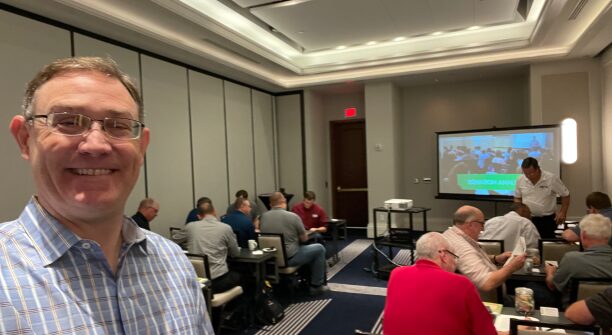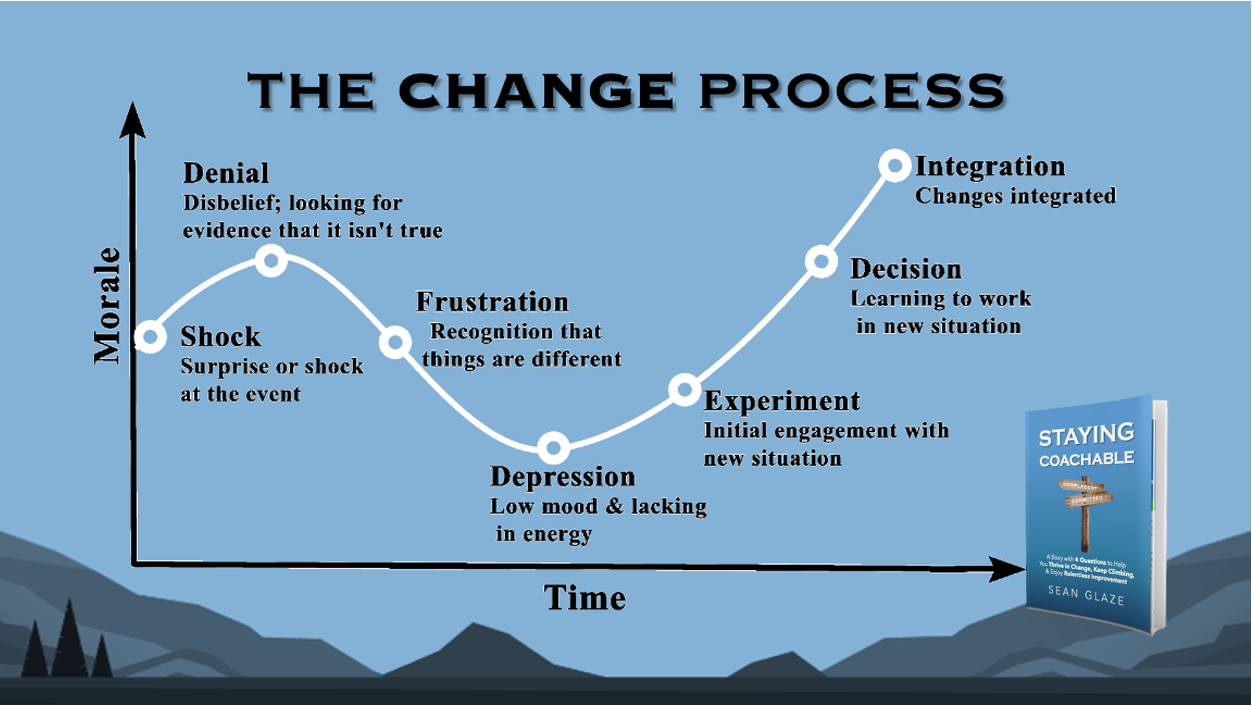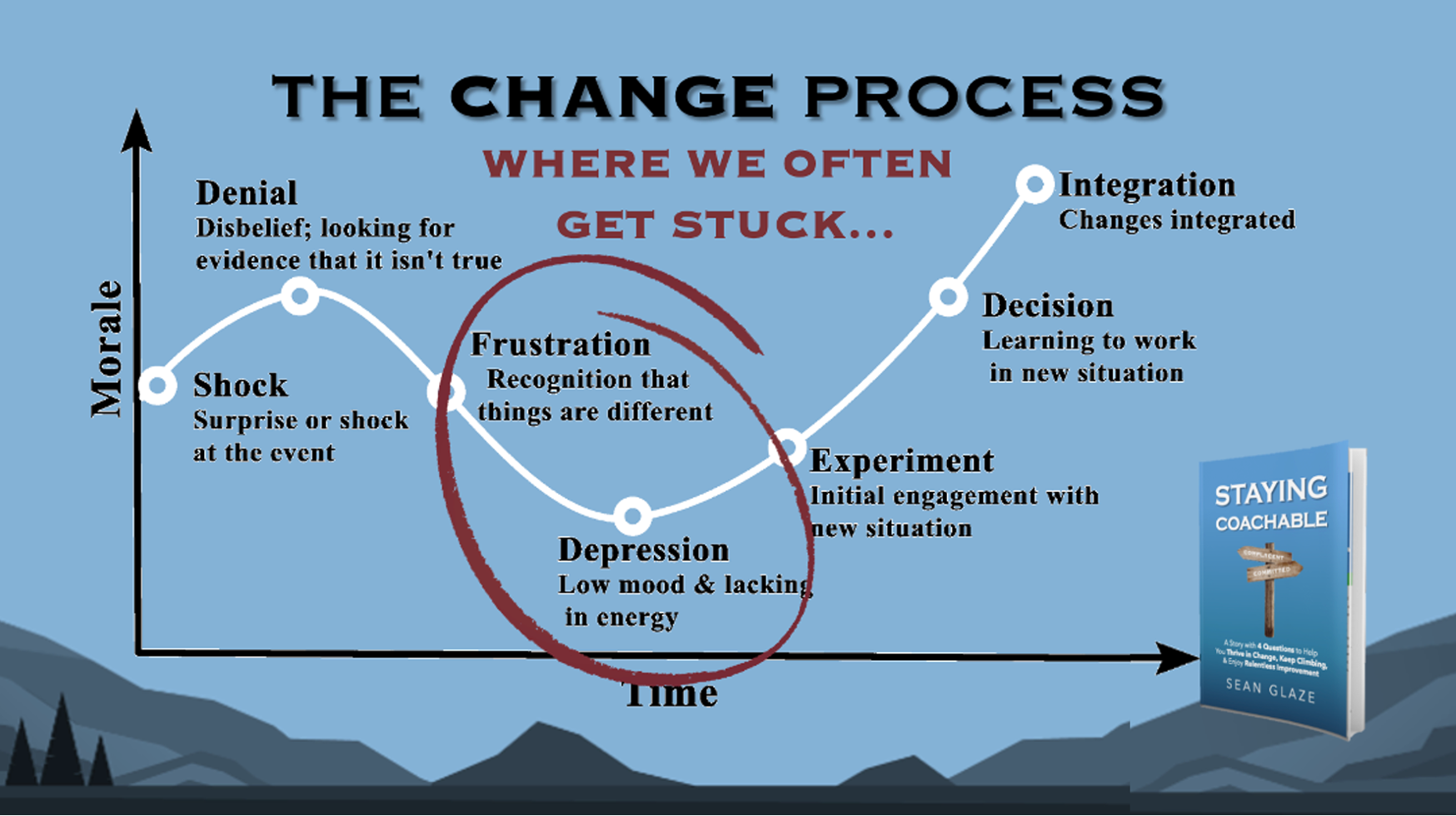As a leader, implementing change on your team can feel like steering through a storm.
Accustomed to comfortable habits, some people resist the necessary alterations that are required to improve productivity or customer experiences…
SO what are the “7 steps of change?”
And how does it SOUND when people are coachable?
What will you HEAR that would let you know things are going well?
Understanding the emotional journey of change – the 7 stages of team adaptation – is crucial for navigating these potentially choppy waters. That’s why it is helpful to be able to recognize what people say in the seven steps of the change process.
You may be surprised to learn that the “change curve” borrows its structure from the five stages of grief outlined by Elisabeth Kübler-Ross in her 1969 book, “On Death and Dying”.
These stages (denial, anger, bargaining, depression, and acceptance) were originally used to describe the emotional journey of terminally ill patients. However, the model’s versatility led to its adaptation into the Kübler-Ross change curve.
This curve helps individuals and organizations understand the emotional responses predict people’s reactions to change and provide adequate support to help people as they transition through a change, be it a new work policy, process, merger, or any other disruption.
STEP 1 OF THE CHANGE PROCESS – Shock:
WHAT IT MIGHT SOUND LIKE:
“Are you serious? Another new program to learn? This is ridiculous!”
Imagine breaking the news about a new platform. You might encounter initial disbelief or deflection. Team members might question the need for change or blame external factors. This “shock response” isn’t malicious; it’s a natural defense mechanism to process the disruption.
Leadership Action: Acknowledge the emotional impact. Validate their concerns and emphasize the purpose behind the change. Openly discuss past successes and how the new approach can help.
STEP 2 OF THE CHANGE PROCESS – Denial:
WHAT IT MIGHT SOUND LIKE:
“I hope they don’t expect me to learn that new software system.”
As the reality of change sets in, self-criticism can take hold. Team members might feel inadequate or question their abilities to adapt. This “realization” stage can manifest as negativity or a decline in morale.
Leadership Action: Foster a supportive environment. Create opportunities for open communication where team members can express their worries. Offer constructive feedback and highlight transferable skills that will benefit them in the new system
STEP 3 OF THE CHANGE PROCESS – Frustration:
WHAT IT MIGHT SOUND LIKE:
“The new software system is so different – it’s a total pain in my backside.”
The self-doubt can morph into frustration and resistance. Team members might openly challenge the change, question its effectiveness, or even “shoot the messenger.” This resistance isn’t personal; it’s a way of regaining control in a situation that feels uncertain.
Leadership Action: Actively listen to their concerns. Address their questions directly and patiently. Provide opportunities for them to participate in the transition, perhaps by offering feedback on platform functionalities or suggesting training approaches.
STEP 4 OF THE CHANGE PROCESS – Depression:
WHAT IT MIGHT SOUND LIKE:
“There’s no way I can figure out this new software.”

When people are depressed, they are often much less likely to engage in activities that would likely improve their situation. With time and support, the intensity of resistance may lessen. Team members begin to “let go” of the old ways and accept the change as inevitable. However, confusion and lingering doubts can still arise. This stage is characterized by questions like “How will this fit into my workflow?” or “Why is this better than the old way?”
Leadership Action: Reiterate the “why” behind the change. Remind team members of the long-term benefits and the positive impact on their work – and help them connect to each other for support with team building activities. Provide clear explanations to dispel confusion.
STEP 5 OF THE CHANGE PROCESS – Exploration:
WHAT IT MIGHT SOUND LIKE:
“This new system might be a better way to complete our new project.”
As the team lets go of the past, they enter a period of exploration. They begin to “search” for meaning in the change. This involves trying out the new system, experimenting with its functionalities, and identifying both its advantages and challenges.
Leadership Action: Encourage experimentation and curiosity. Offer ongoing support through readily available resources, such as training materials, tutorials, and FAQs. Celebrate early wins and acknowledge the challenges they’re actively overcoming.
STEP 6 OF THE CHANGE PROCESS – Decision:
WHAT IT MIGHT SOUND LIKE:
“The new software has a few issues, but it is better for the team.”
For those who persevere through the previous stages, a sense of acceptance emerges. Team members begin to “understand the meaning of change” and recognize its value. They see how the new system complements their work and contributes to the organization’s goals.
Leadership Action: Acknowledge and celebrate their progress. Encourage knowledge sharing among team members who have grasped the new system. Foster an environment of continuous learning and exploration.
STEP 7 OF THE CHANGE PROCESS – Integration:
WHAT IT MIGHT SOUND LIKE:
“I’m pretty comfortable using the software now – and it’s so helpful!”
The ultimate goal: full team “change acceptance.” This stage signifies a natural integration of the new process or platform into their work routine. Team members confidently leverage the system’s functionalities, readily identify its benefits, and even contribute to further improvements.
Leadership Action: Empower your team to take ownership. Encourage them to suggest further improvements and explore advanced features. Recognize their contributions and celebrate their successful adaptation.

Why Invest in Your Team Being Coachable?
Guiding your team through these stages requires patience, empathy, and a commitment to fostering a coachable environment. A coachable team is one that embraces learning opportunities, readily seeks feedback, and demonstrates a willingness to adapt.
Here’s why investing in Staying Coachable is a win for you and your team:
- Enhanced Adaptability: In today’s fast-paced business landscape, change is constant. A coachable team can thrive in this environment, readily embracing new processes and technologies.
- Improved Problem-Solving: Coachable team members are more receptive to feedback and open to new approaches. This fosters a collaborative problem-solving environment, leading to more efficient and innovative solutions.
- Increased Employee Satisfaction: When employees feel supported in their learning and growth, they are more likely to feel valued and engaged in their work. This leads to higher morale and job satisfaction.
– – – – –
Sean Glaze is an author and leadership expert who has worked with clients like Cisco, John Deere, Coca- Cola, and Emory University to increase collaboration, boost productivity, and build exceptional workplace cultures.
Cola, and Emory University to increase collaboration, boost productivity, and build exceptional workplace cultures.
As a successful basketball coach and educator for over 20 years, Sean gained valuable insights into leading winning teams – and now he travels around the country to share those lessons…
Sean’s engaging conference keynotes and interactive team building events help accelerate the growth of more effective leaders.
And Sean’s books, Rapid Teamwork, The 10 Commandments of Winning Teammates, and Staying Coachable are entertaining parables with powerful take-aways to improve team performance and leadership!




